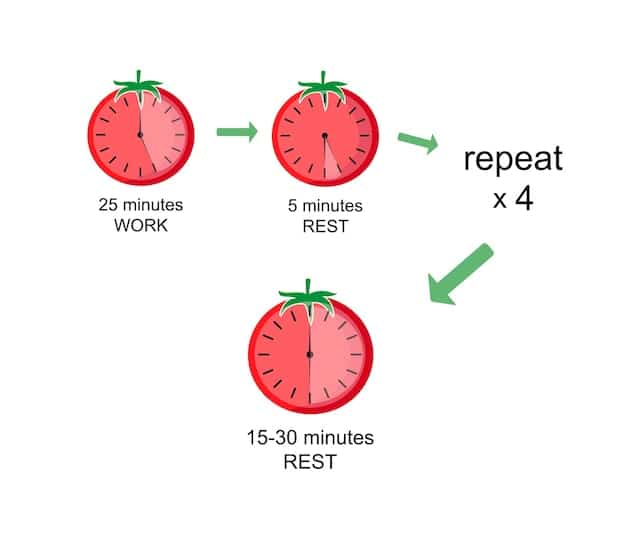Boost Your Focus: The Pomodoro Technique for Peak Productivity

Improve Your Focus: The Power of Pomodoro Technique for Increased Productivity lies in its structured approach to time management, breaking work into focused intervals with short breaks to enhance concentration and prevent burnout.
Do you find yourself constantly distracted, struggling to concentrate on your tasks? The feeling of being overwhelmed and unproductive is all too common. But what if there was a simple, effective technique to **improve your focus: the power of Pomodoro Technique for increased productivity**? This method could be your answer to a more focused and productive work life.
Understanding the Pomodoro Technique
The Pomodoro Technique is a time management method developed by Francesco Cirillo in the late 1980s. It uses a timer to break down work into intervals, traditionally 25 minutes in length, separated by short breaks. The goal is to provide the user with maximum focus and creative freshness, enabling them to complete tasks more effectively.
The Origins of the Pomodoro Technique
The technique gets its name from the tomato-shaped kitchen timer that Cirillo used as a university student. Frustrated with his inability to concentrate on his studies, he challenged himself to focus for just 10 minutes. Using the timer, he found that short, focused bursts of activity, interspersed with regular breaks, boosted his concentration and productivity.
The Core Principles
The Pomodoro Technique is based on the idea that frequent breaks can improve mental agility. By breaking tasks into manageable chunks, it helps to combat procrastination and enhances concentration. It encourages individuals to work *with* their natural tendencies, rather than against them, leading to a more sustainable and enjoyable work process.

- Planning: At the beginning of the day, plan which tasks you intend to complete.
- Timing: Set a timer for 25 minutes and focus solely on the task at hand.
- Taking Breaks: After the timer rings, take a short break (3-5 minutes).
- Repeating: Repeat the Pomodoro cycle four times, then take a longer break (20-30 minutes).
The Pomodoro Technique provides a simple yet powerful framework for time management. It allows individuals to approach their work with clarity and focus, reducing the stress associated with large, daunting tasks.
Setting Up Your Pomodoro Workspace
Creating an effective workspace is essential for maximizing the benefits of the Pomodoro Technique. A well-organized and distraction-free environment can significantly enhance your focus and productivity. By setting up your physical and digital workspace correctly, you can ensure that you stay on track and maintain concentration throughout your work sessions.
Physical Environment
Your physical workspace should be tidy and organized. Remove any unnecessary items that could cause distraction. Ensure that you have adequate lighting and a comfortable chair to prevent physical discomfort during work sessions. A clean and clutter-free environment supports a clear and focused mind, making it easier to concentrate on your tasks.
The Importance of Ergonomics
Ergonomics plays a crucial role in maintaining focus and productivity. Proper posture can prevent physical strain and discomfort, allowing you to work longer without fatigue. Position your monitor at eye level, use a supportive chair, and ensure that your keyboard and mouse are within easy reach. Taking care of your physical comfort is an investment in your productivity.
Consider incorporating elements such as plants or a calming color scheme to create a more pleasant and conducive work atmosphere. Personalizing your workspace with items that inspire and motivate you can also contribute to increased productivity and focus.

- Minimize Distractions: Turn off notifications on your phone and computer.
- Use Noise-Canceling Headphones: Block out external sounds that could disrupt your focus.
- Organize Your Desk: Keep only essential items within reach.
By implementing these strategies, you can create a workspace that fosters concentration and boosts your productivity. A well-prepared workspace is an invaluable asset when practicing the Pomodoro Technique.
Implementing the Pomodoro Technique Step-by-Step
The Pomodoro Technique is a straightforward method, but following a clear, step-by-step process can help you maximize its effectiveness. Understanding each phase and adapting it to your personal workflow ensures optimal results. Consistency in following these steps is key to developing a productive habit.
Step 1: Define Your Task
Start by identifying the specific task you want to accomplish during a Pomodoro session. Breaking down large projects into smaller, manageable tasks makes them less daunting and easier to tackle. Clearly defining your objective helps you maintain focus and measure your progress effectively.
Step 2: Set the Timer
Set a timer for 25 minutes. This is the standard duration for a Pomodoro session. Many free timer apps and websites are available, or you can use a traditional kitchen timer. The important thing is to commit to working solely on your defined task until the timer rings.
Once the timer starts, dedicate your full attention to the task at hand, avoiding any distractions or interruptions. If unrelated thoughts arise, jot them down on a piece of paper to address later, ensuring they don’t derail your focus. Stay completely committed to the task for the entire 25-minute interval.
- Stay Focused: Avoid multitasking and distractions.
- Use a Timer: A physical or digital timer works well.
- Commit: Dedicate the entire 25 minutes to one task.
Committing to each step consistently will help you harness the full power of the Pomodoro Technique and increase your overall productivity.
Customizing the Pomodoro Technique for Your Needs
While the traditional Pomodoro Technique is effective, adapting it to your individual needs can enhance its benefits. Customization allows you to optimize the technique to align with your personal work style and preferences. Adjusting the duration of work intervals and breaks, or integrating the technique with other productivity methods, helps you create a system that works best for you.
Adjusting Time Intervals
The standard 25-minute work interval may not suit everyone. Some individuals may find it beneficial to lengthen the interval to 45 or 60 minutes, while others may prefer shorter bursts of 15 or 20 minutes. Experiment to find the duration that allows you to maintain optimal focus without feeling overwhelmed. Similarly, adjust the length of your breaks to suit your recovery needs and preferences.
Tailoring Breaks
Short breaks can be customized to include activities that help you relax and recharge. Whether it’s stretching, meditating, listening to music, or simply stepping away from your workspace. Tailoring your breaks can maximize their restorative effects, leading to higher levels of concentration and productivity during subsequent work intervals.
Combining the Pomodoro Technique with other time management strategies allows you to create a comprehensive productivity system tailored to your unique needs. Experiment with different approaches to find the most effective combination for enhancing your focus and productivity.
- Longer Sessions: Try 45-60 minute sessions if you can maintain focus.
- Shorter Breaks: Experiment with varied break activities.
- Combine Techniques: Integrate with time blocking or task batching.
By customizing the Pomodoro Technique to suit your individual work style and needs, you can unlock its full potential and achieve sustainable improvements in focus and productivity.
Overcoming Challenges and Common Pitfalls
While the Pomodoro Technique is a powerful tool for enhancing focus, it’s not without its challenges. Recognizing common pitfalls and developing strategies to overcome them can help you maximize the technique’s effectiveness. Addressing issues such as distractions, perfectionism, and burnout ensures that you maintain a sustainable and productive workflow.
Dealing with Distractions
Distractions can disrupt your focus and derail your Pomodoro sessions. Identifying your primary sources of distraction is the first step in managing them effectively. Whether it’s social media, email notifications, or external noise, implementing strategies to minimize these interruptions can significantly improve your concentration.
Managing Perfectionism
Perfectionism can hinder productivity by causing you to spend excessive time on a single task. Recognizing when you’re striving for perfection rather than progress can help you reframe your approach. Setting realistic goals and focusing on completing tasks rather than perfecting them allows you to maintain momentum and avoid getting bogged down.
Preventing burnout is essential for maintaining long-term productivity and well-being. Recognizing the signs of burnout and implementing strategies to address it ensures that you can sustain a healthy and productive work life.
- Block Distractions: Use website blockers or turn off notifications.
- Set Realistic Goals: Focus on completion, not perfection.
- Prioritize Self-Care: Ensure adequate rest and breaks.
By anticipating and addressing these challenges, you can fine-tune your approach to ensure sustainable improvements in focus and productivity.
The Science Behind the Pomodoro Technique
The effectiveness of the Pomodoro Technique is supported by scientific principles related to focus, attention, and cognitive function. Understanding the science behind why it works can provide additional motivation to implement the technique consistently. By breaking work into focused intervals and incorporating regular breaks, the Pomodoro Technique aligns with the brain’s natural rhythms and enhances overall productivity.
The Science of Focus
The human brain is not designed for sustained, uninterrupted focus. Studies have shown that our attention spans are naturally limited, and we benefit from regular breaks to refresh our cognitive resources. The Pomodoro Technique leverages this understanding by providing structured periods of intense focus followed by short periods of rest.
The Benefits of Breaks
Breaks are essential for cognitive recovery and preventing mental fatigue. During breaks, the brain can consolidate information, process emotions, and restore energy levels. Incorporating regular breaks into your work routine enhances your ability to sustain focus and maintain high levels of productivity over extended periods.
Implementing strategies based on these scientific findings can further enhance the Pomodoro Technique’s effectiveness. By understanding the science behind why it works, you can optimize your approach and achieve even greater improvements in focus and productivity.
- Attention Span: Recognize natural limits in focus duration.
- Cognitive Recovery: Understand the importance of breaks for refreshing the mind.
- Brain Rhythms: Align your work habits with the brain’s natural patterns.
Understanding the science supporting the Pomodoro Technique helps confirm the value of this proven productivity method.
| Key Element | Benefit |
|---|---|
| ⏱️ Timed Intervals | Enhances focus and concentration through structured work periods. |
| ☕ Regular Breaks | Prevents burnout and mental fatigue by allowing cognitive recovery. |
| ✅ Task Management | Breaks down large tasks, making them less daunting and more achievable. |
| 🎯 Productivity | Increases work output and efficiency through consistent focus and rest. |
Frequently Asked Questions
▼
The standard duration for a Pomodoro session is 25 minutes of focused work, followed by a 5-minute break. After completing four Pomodoro sessions, it’s recommended to take a longer break of 20-30 minutes.
▼
Yes, you can adjust the length of the work intervals and breaks to suit your individual needs and preferences. Experiment with different durations to find what works best for you.
▼
If you get distracted during a Pomodoro session, gently redirect your attention back to the task at hand. If the distraction is significant, jot it down to address later during your break.
▼
Yes, the Pomodoro Technique can be very effective for managing procrastination. By breaking tasks into smaller, manageable intervals, it reduces the feeling of being overwhelmed and makes it easier to get started.
▼
The Pomodoro Technique can be adapted for a wide range of tasks and work environments. However, it may be more effective for tasks that require focused concentration and can be broken down into discrete intervals.
Conclusion
In conclusion, mastering the Pomodoro Technique provides a structured and scientifically supported method to enhance focus, manage time effectively, and boost overall productivity. By understanding the core principles, customizing the technique to fit individual needs, and overcoming common challenges, anyone can leverage the power of Pomodoro to achieve their goals and create a more balanced and productive work life.





